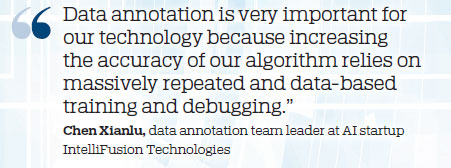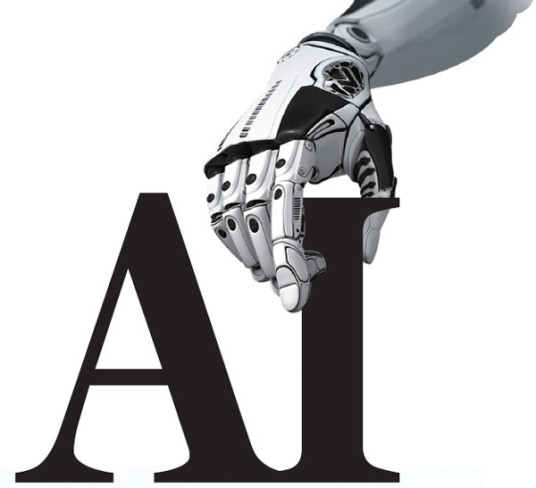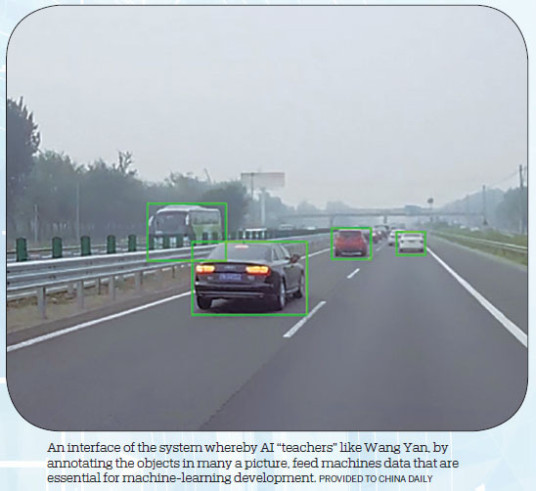AI 'teachers' join in the tech race
The demand for data labelling has boomed as leading enterprises across a wide spectrum of industries throw their hats in the ring in developing artificial intelligence technology. The Chinese mainland has come up on top as posting the sector's highest growth rate worldwide. Chai Hua reports.
Wang Yan tactfully navigates the mouse as she tries to frame out a car in a photo on her computer. Some of the car images are so small she has to zoom in on them hard or hunch over to get a clearer picture.
The frame lines need to be almost exact along the edges of the target object. For trucks, she does not circle out cargo high above, but containers are marked in.
Moving to the next photo, she sees an empty road, except for a front wheel in the photo's left corner. Wang leaves it out because the instruction rules against tagging vehicles that expose less than 10 percent of their bodies.
Sometimes, the job is easier. She only needs to record if the photo is clear, or whether the man in the photo is facing the camera or if his eyes are open.
Or, she corrects the dictation of a clip of recording and notes down which person in the dialogue is uttering which sentences.
Whether the job is arduous, easy or otherwise, the work seems strange to most people, but the outcome is familiar to everyone - self-driving cars in the news, face-recognition cameras or fluent communication with voice assistants like Siri.
These are the common applications of cutting-edge artificial intelligence, but before such magic comes true, AI devices have to be trained, by humans, using the most traditional method - enormous knowledge feeding and practice.
Wang's work is to "teach" AI to pick up these abilities. It's called data labeling, or annotation, and its demand is booming as scores of top companies across all industries have thrown their hats in the ring to develop AI technology.
Although it seems like very low-tech work, industry insiders believe the market actually promises huge potential.
According to a recent report by global professional services group Deloitte, the value of China's AI market is projected to surpass 30 billion yuan ($4.3 billion) by the end of this year - one of the countries with the fastest growth rates in the sector.
The demand for AI "teachers" on the Chinese mainland is also on the rise although the nature of the work is less known to the public. Media reports say there are about 1 million part-timers like Wang in the country's data labeling business.
Wang has been in the job for seven years part-time, including all weekends if she's available and three hours after work every other night on weekdays.
The 36-year-old takes in about 3,000 to 4,000 yuan monthly as extra income, supplementing her full-time accounting job in Beijing.
There are also thousands of small workshops with full-time workers, scattered in second- and third-tier mainland cities with lower labor costs.
Clients of these small- and medium-sized workshops are companies engaged in developing self-driving, facial recognition or other AI-related products.
Some workshops have expanded considerably. A crowdsourcing platform called Stardust gathered more than 20,000 university students, while data service provider BasicFinder has 12 affiliated data factories and 2,000 full-time annotators.
Message for investors
According to BasicFinder, its orders in the first quarter of this year had soared 260 percent over the same period in 2017, and its annual figure is expected to triple last year's record.
The development of the data labeling industry has caught the attention of investment enterprises. Earlier this month, data service provider Databaker Technology said it had completed its Series A financing round of 50 million yuan, while Stardust had secured 10 million yuan early this year.
For industry giants like Baidu and JD.com, they've set up their own outsourcing platforms for data annotation.
JD's outsourcing platform, created late last year, has about 40,000 registered data markers, including 1,000 disabled people, according to its website. Annotators who perform well stand being promoted to "collectors", "experts", "high-level experts" and "instructors".
China is not the only nation that's witnessing a surge in the industry. In the US, Amazon's outsourcing platform of data annotation tasks, Amazon Mechanical Turk, has about half million registered users.
The reason for the boom is that these "processed" data are paramount for AI applications.
"Data annotation plays an important role in the development of AI and machine learning," said Li Wenye, research assistant professor of the Chinese University of Hong Kong (Shenzhen) and the Shenzhen Research Institute of Big Data.
"One important area of machine learning is supervised learning. Given input and output, supervised learning tries to detect the relationship between them and then the computer will be able to generate the output automatically for an input in future," said Li.
As an example, he cited how a computer can recognize a new image after learning from many images (inputs) and corresponding captions (outputs).
Therefore, he reiterated, the success of supervised learning depends heavily on the availability and quality of a large volume of training data but, unfortunately, in practice, we often have a huge amount of source data (inputs), but lack target data (outputs), such as labeled images.
A complicated process
He believes that special manual annotation seems to be a remedy in order to provide adequate training data.
Sun Bo, head of the self-driving technology team at Shanghai-based startup Westwell Lab, agreed, saying it needs thousands of tagged photos to train their system to recognize lane markers.
Although they focus on developing self-driving trucks to transport containers at ports - a relatively uncomplicated environment - he said there are still many varieties.
"We need to consider different light and shadow, slight changes of obstacles, colors of lane markers and even any loss of paint," he explained.
Compared with ordinary traffic signs, teaching AI to accurately find the container hanging holes is even more complicated - 10 times more precisely tagged images are needed!
"Nowadays, many algorithms are open-source so the one who has more labeled data to optimize its product will stand out," he stressed.
His team chooses to outsource their data to labeling workshops because it's much cost-efficient. After all, it takes about only 1 yuan to annotate one photo.

But, some AI firms have formed their own teams. IntelliFusion Technologies - a Shenzhen-based AI startup - established its own data annotation group in 2016 and has expanded to about 100 employees so far.
When asked why they've internalized the work, team leader Chen Xianlu explained that it's for the sake of high quality and information safety.
IntelliFusion focuses on facial recognition products that can locate a person among a million in just one second.
"Data annotation is very important for our technology," said Chen, "because increasing the accuracy of our algorithm relies on massively repeated and data-based training and debugging".
So far, his team has processed above 100 million units of visual data, including photos and video clips.
However, he admitted it would take a long time to actually see the result of the cost until the firm's product finally hits the market, but the market potential of data labeling is still huge.
Many people argue that data annotation creates only labor-intensive jobs at the bottom end of the value chain, like Foxconn's OEM factories in the early days.
However, Chen holds a different perspective. "Manual labeling only is low in technology threshold, but profitable for sure. But, combining it with automatic annotation and even self-training system is not low-tech at all."
Upbeat about the industry's future, the company is preparing a platform to provide labeling services for other enterprises, and expects to launch it next year with the goal of leading the pack in the domestic market.
Chen said their advantage is "automatic annotation" supported by AI technology, which is still a vacancy in the market for now.
Inserting AI to improve manual annotation efficiency has become a trend among large data firms.
In October, Google released a solution, Fluid Annotation, empowering machine learning itself to annotate category labels and outline every object in a picture. It promises to increase labeling time as much as three times.
JD also has a Pre-AI solution combining AI and human annotators. It claims to finish a task in one week with accuracy rate of 99 percent, which takes two months using the traditional method.
Another opportunity is to process data in industries that require professional knowledge, such as AI doctors and translators.
Miao Guanqiong, co-founder and chief project officer of Databaker Technology, said there're too many firms working on entry-level labeling tasks, so it's critical to find differentiated advantages.
The differentiation of her startup is synthesis voice and voice recognition. "The segment needs professional language skills about tone, semantics, etc," she said, adding that most of their full-time annotators have more than 10 years of working experience.


